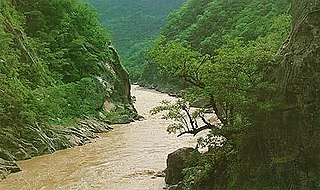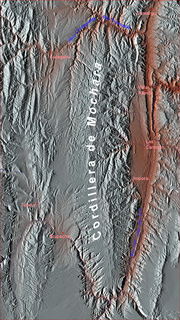
Pilcomayo is a river in central South America. At 1,100 kilometres (680 mi) long, it is the longest western tributary of the Paraguay River. Its drainage basin is 270,000 square kilometres (100,000 sq mi) in area, and its mean discharge is 200 cubic metres per second (7,100 cu ft/s).
Jatun Mayu which upstream is called Tinkipaya is a Bolivian river in the Potosí Department, Tomás Frías Province, Tinkipaya Municipality, Tinkipaya Canton, north of Potosí. It is a left tributary of the upper Pillku Mayu. The confluence is about 10 km south east of Tinkipaya.
Kachi Mayu is a Bolivian river east of Poopó Lake in the Oruro Department, Challapata Province, Challapata Municipality. Its source, the Jach'a Juqhu River, is considered the origin of the Pillku Mayu.
Kachi Mayu is a Bolivian river in the Chuquisaca Department, Oropeza Province, in the Sucre and Yotalla Municipalities. It is a left tributary of the Pillku Mayu, not to be confused with the Kachi Mayu in the Oruro Department which is the headwater of the Pillku Mayu. The confluence is on the border of the Yotalla Municipality and the Potosí Department, west of the village of Tasapampa.
Ch'aki Mayu, also Kachi Mayu, is a Bolivian river in the Potosí Department. It flows towards the Pillku Mayu.
Jayaq Mayu is a Bolivian river in the Potosí Department, Tomás Frías Province, in the south of Potosí. It originates on the west side of the mountain Cerro Rico or P'utuqsi Urqu located in the Potosí Municipality. Then it flows in a north west direction until meeting Agua Dulce River in the Yocalla Municipality. This river shortly afterwards forms the Tarapaya River at its confluence with Ribera de la Vera Cruz. Jayaq Mayu belongs to the Pillku Mayu drainage basin.
Inka Wasi is a Bolivian river in the Chuquisaca Department, Nor Cinti Province. It is a left tributary of the Pilaya River, an important right affluent of the Pillku Mayu.

Chiñi Mayu is a Bolivian river in the Chuquisaca Department, Nor Cinti Province, San Lucas Municipality and Camargo Municipality. It belongs to the Pillku Mayu river basin.

Pillku Urqu, also known as Pikul, Piqul or Wayna Piqul, is a 4,448-metre-high (14,593 ft) mountain in the Andes of Peru, near the city of Cusco. It is situated in the Cusco Region, Calca Province, Taray District, and in the Cusco Province, San Jerónimo District, north of San Jerónimo.

Jatun Q'asa is a 4,590-metre-high (15,059 ft) mountain in the Bolivian Andes. It is situated in the Potosí Department, Tomás Frías Province, Potosí Municipality. Some of the nearest settlements are Umallani and Salla K'uchu. Jatun Q'asa lies east Wayra Wasi, between the Ch'aki Mayu in the west and the Challwiri River (Challviri) in the east. Both rivers flow to the north as right tributaries of the Pillku Mayu.

Mulli Urqu is a 2,906-metre-high (9,534 ft) mountain in the Bolivian Andes. It is located in the Chuquisaca Department, Oropeza Province, Yotala Municipality. Mulli Urqu lies west of the Kachi Mayu which is a left tributary of the Pillku Mayu.
Jatun Mayu is a Bolivian river in the Chuquisaca Department, Jaime Zudáñez Province, Icla Municipality. It is a left affluent of the Icla River. It belongs to the watershed of the Pillku Mayu.

Uritu Mayu is a Bolivian river in the Chuquisaca Department, Jaime Zudáñez Province, Icla Municipality. It is a left affluent of the Pillku Mayu.

Wallqayuq Urqu is a 4,124-metre-high (13,530 ft) mountain in the Bolivian Andes. It is located in the Chuquisaca Department, on the border of the Azurduy Province, Tarvita Municipality, and the Jaime Zudáñez Province, Icla Municipality. Wallqayuq Kimray lies west of Wisk'achani and northeast of Wanaku Kimray. The Phaqcha Mayu originates south of the mountain. It flows to the south as an affluent of the Qucha Mayu which downstream is named San José. It is a left tributary of the Pillku Mayu.

Chhichayuq is a 3,846-metre-high (12,618 ft) mountain in the Bolivian Andes. It is located in the Chuquisaca Department, Azurduy Province, Tarvita Municipality. Chhichayuq lies northwest of Wisk'achani and northeast of Wallqayuq Urqu. The Qucha Mayu which downstream is named San José originates northwest of the mountain. It is a left tributary of the Pillku Mayu.

Inka Wasi is a 3,146-metre-high (10,322 ft) mountain in the Bolivian Andes. It is located in the Chuquisaca Department, Azurduy Province, Tarvita Municipality. Inka Wasi lies southwest of Muyu Urqu and north of Pukara. The Laqha Mayu originates north of the mountain. Its waters flow to the Pillku Mayu.

Tawa Qucha is a 3,582-metre-high (11,752 ft) mountain in the Bolivian Andes. It is located in the Chuquisaca Department, Azurduy Province, Tarvita Municipality. It lies at the Tawa Quchayuq Mayu whose waters flow to the Pillku Mayu :

Wañuma is a 4,202-metre-high (13,786 ft) mountain in the Andes of Bolivia. It is located in the Potosí Department, Cornelio Saavedra Province, Tacobamba Municipality. Wañuma lies on the right bank of the Ch'aki Mayu. Its waters flow to the Pillku Mayu :

Qiñwa Qullu is a mountain in the Andes of Bolivia which reaches a height of approximately 4,160 m (13,650 ft). It is located in the Potosí Department, Cornelio Saavedra Province, Tacobamba Municipality. Qiñwa Qullu lies on the left bank of the Ch'aki Mayu. Its waters flow to the Pillku Mayu :

T'uqu Chaka is a 4,164-metre-high (13,661 ft) mountain in the Andes of Bolivia. It is located in the Potosí Department, Cornelio Saavedra Province, Tacobamba Municipality. T'uqu Chaka lies between Qiñwa Qullu in the northeast and Wañuma Q'asa in the southwest. It is west of the Ch'aki Mayu. Its waters flow to the Pillku Mayu.








